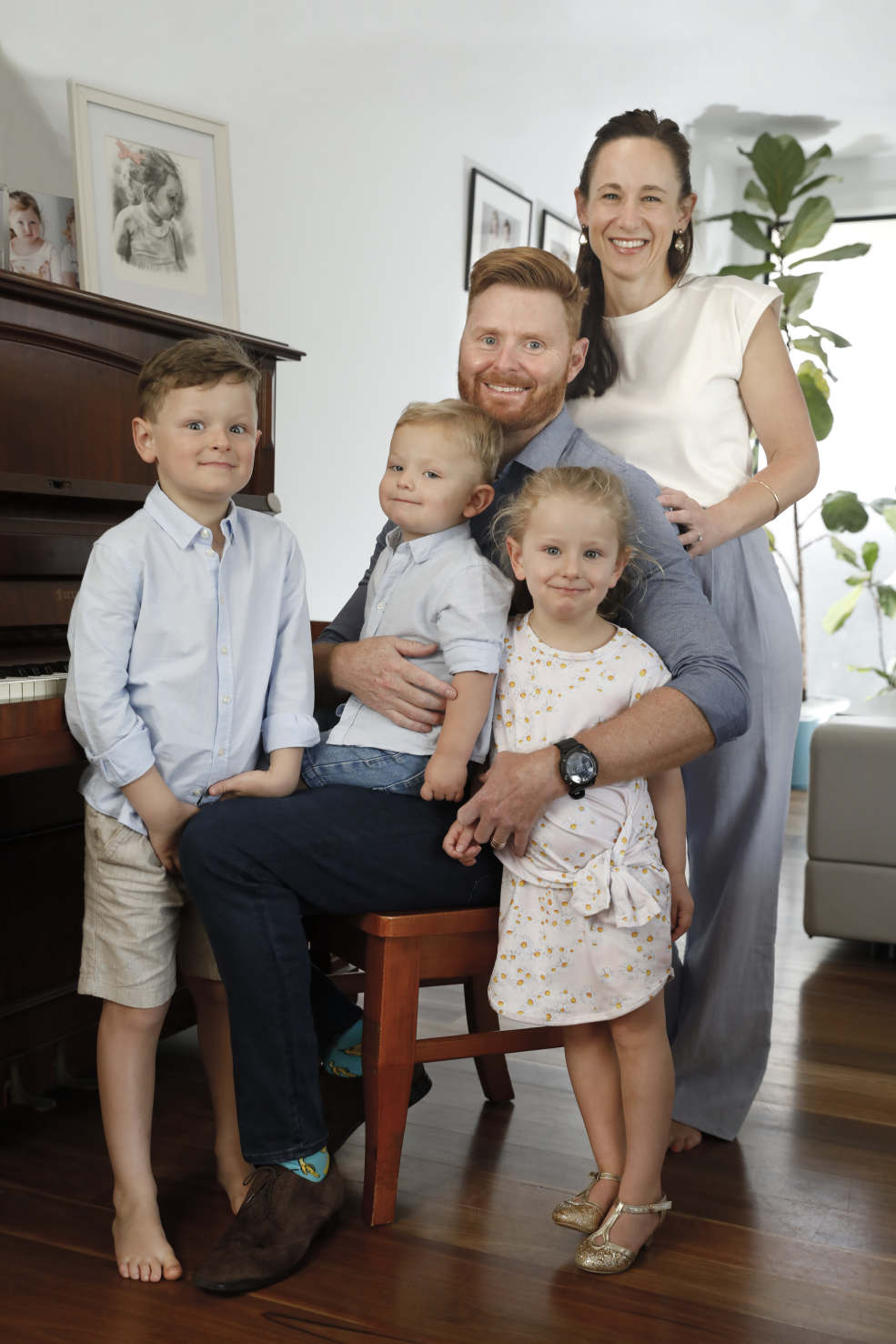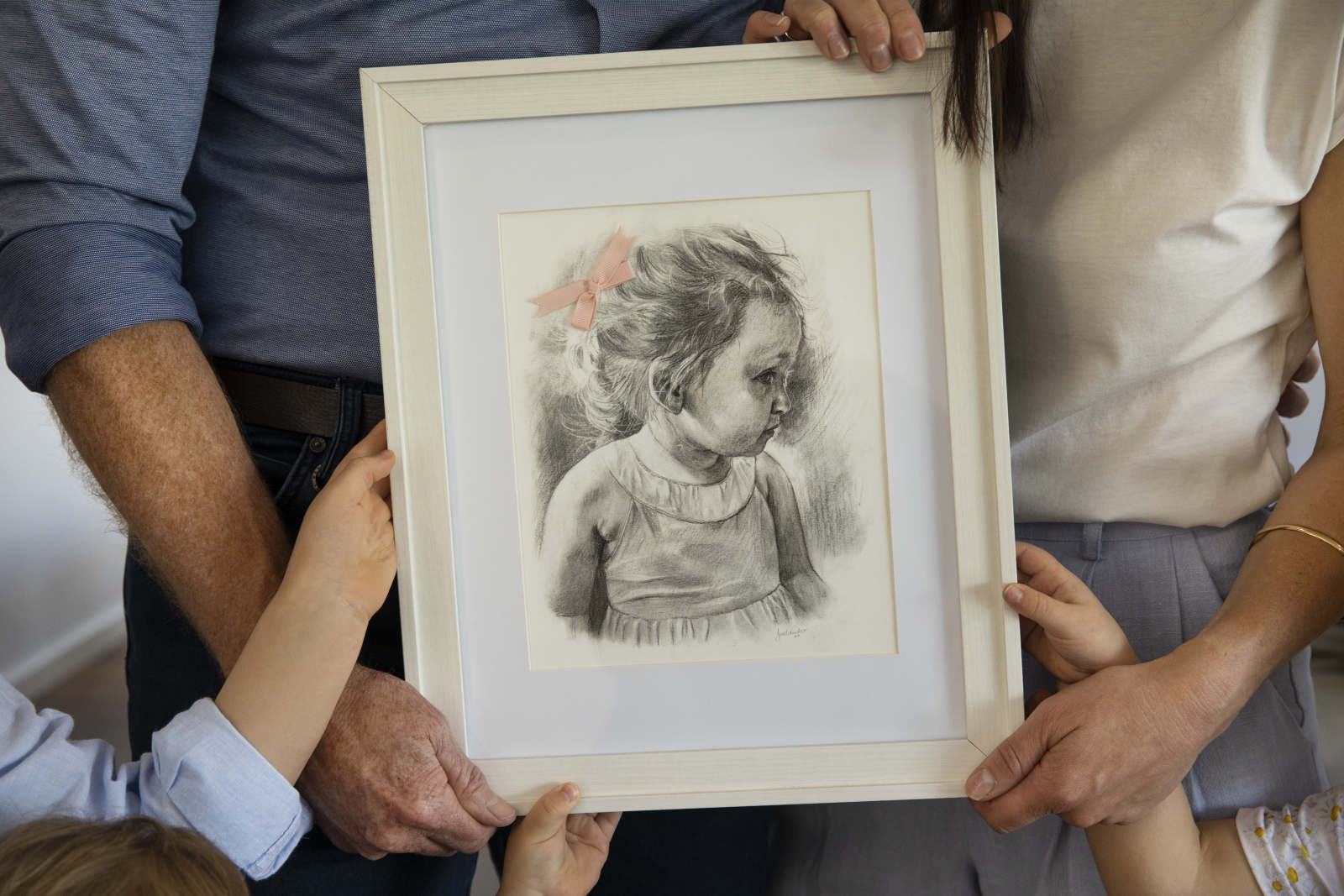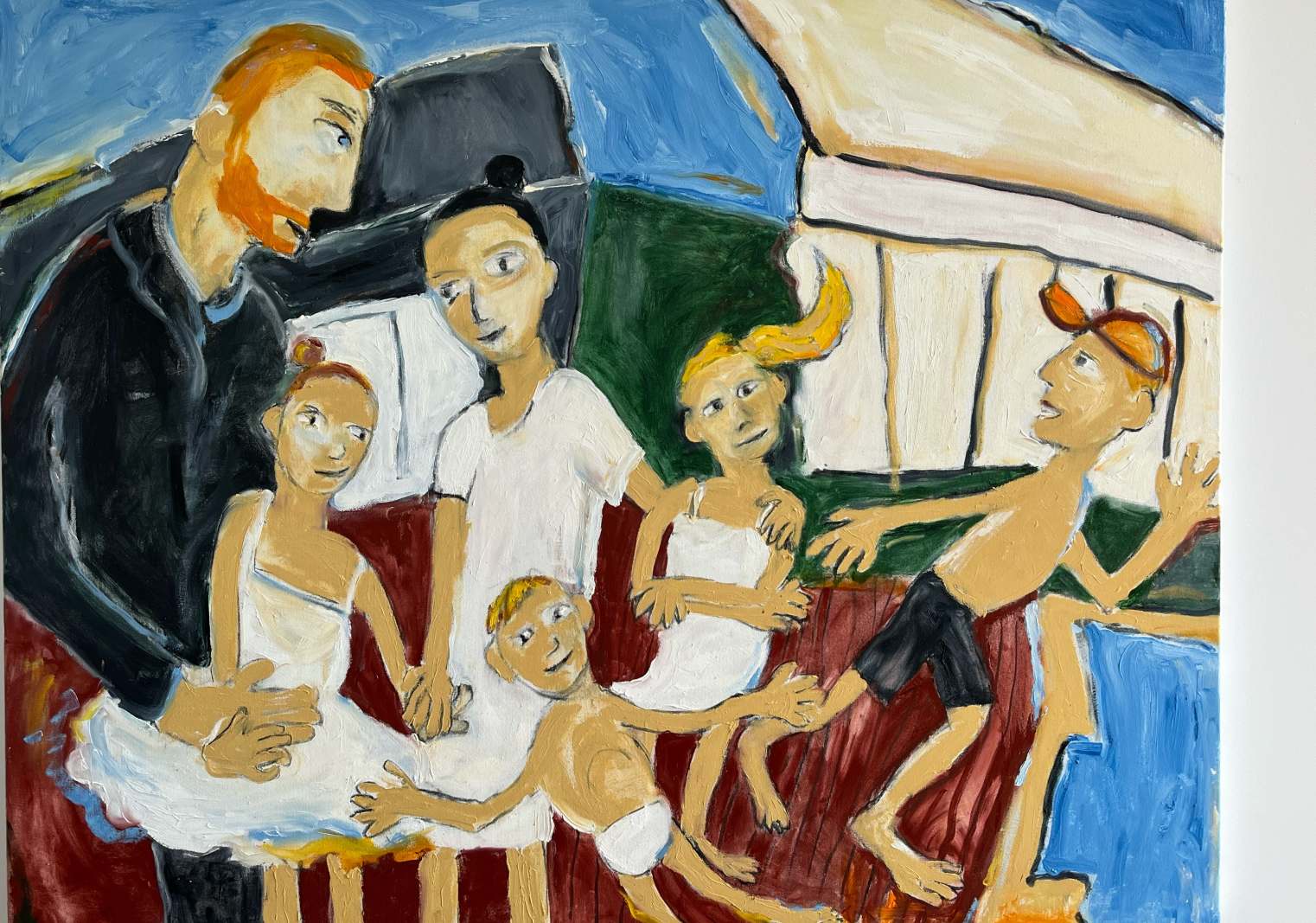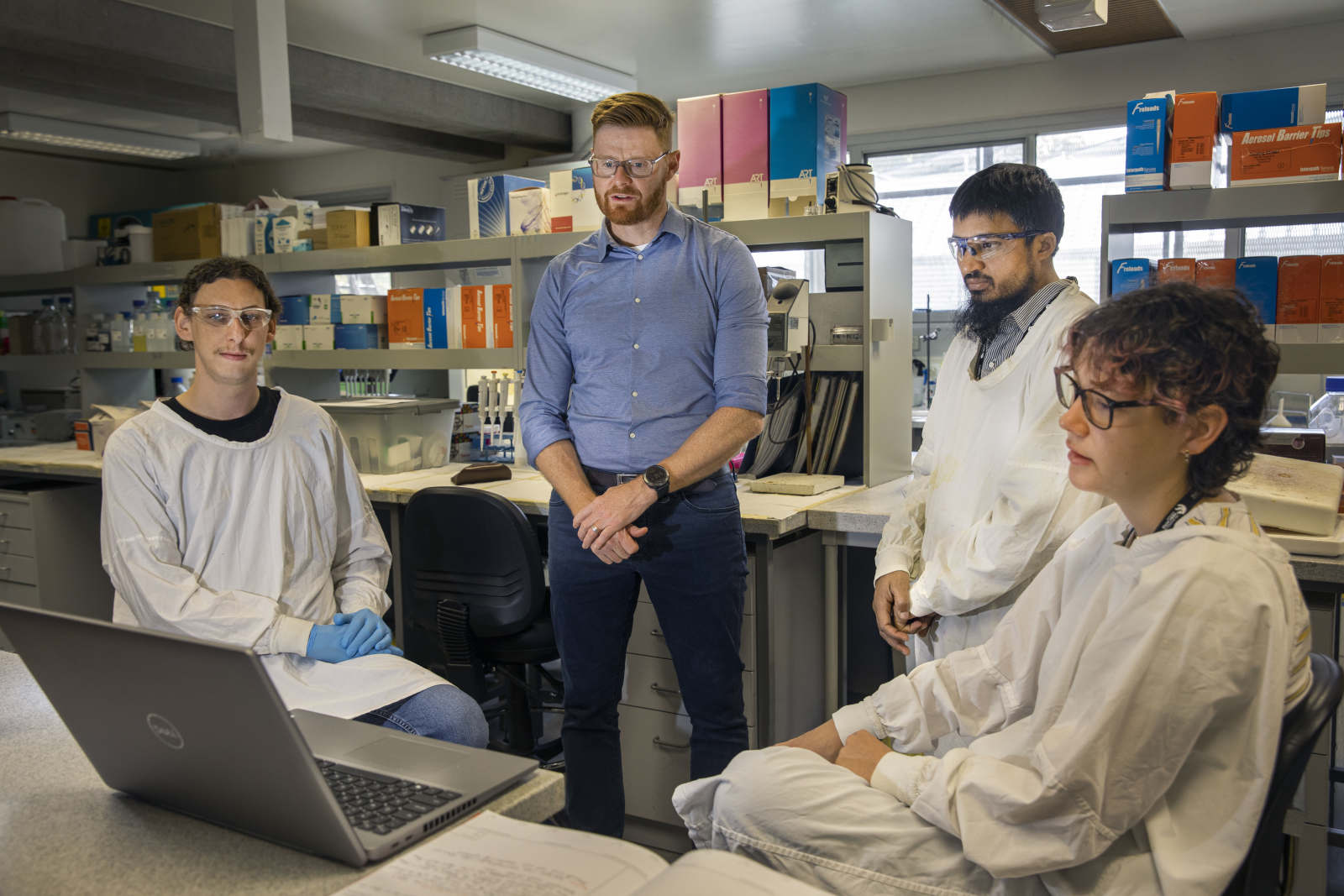The Sydney Morning Herald/ Good Weekend
December 9 2022
Article: Liz Gooch
Images: Chris Elfes
On a rainy Wednesday morning at his family’s Newcastle home, Matt Dun’s 189-centimetre frame is parked at the dining table among three children’s booster seats. As the 44-year-old describes his early life, it becomes clear he has an unusual pedigree for a biomedical scientist. After growing up in Canberra, he left school at the beginning of year 11 and headed west, joining the Royal Australian Navy’s submarine squadron in Perth.
Long stretches at sea were punctuated with episodes of high adrenalin, negotiating storms and swells. Matt loved the camaraderie of the navy, but had promised his mum that one day he’d go to university. After six years in Perth, he moved to the Sydney Naval Base so that he could study his Higher School Certificate at TAFE at night.
“I just wanted to buy her time, with the hope that something would come for her. We were running.”
Submitting his discharge papers a couple of years later, he swapped sea life for campus life, enrolling in a bachelor’s of biotechnology at the University of Newcastle, playing rugby union and working in his father’s pub in the same city, where he’d meet the young woman he would later marry.
Learning to study again at the age of 26 was a big adjustment. “I had such an adventurous life … and then I’m stuck in a library, learning to write,” Matt says. “It was a good leveller, but I really warmed to it.”
Phoebe’s résumé has fewer kinks. After a false start with an economics degree, she switched to medicine at the University of Newcastle, deciding to follow in the footsteps of her GP father.
A few years after the couple married, they were elated to discover she was pregnant. When their baby’s heart rate dropped dangerously low during birth, the doctor rushed to deliver her, but Josephine Laura Dun was soon given the all-clear. The couple took her home to their house in suburban Newcastle and began getting to know their new daughter.
“She was always a character, wasn’t she?” says Phoebe, the petite 37-year-old smiling warmly across the dining table at her husband. “She was very easy-going, very happy, very lovable, and intelligent … The first thing we noticed about her was her giggle. It was infectious. And everybody knew her for it.”
Nothing in those early days hinted at the catastrophic blow that would come less than three years later.
By the time Josie was diagnosed with DIPG, the Duns had had their second child, George, Phoebe was working part-time as a GP, and they were living with her parents while renovating an old home they’d bought. Matt had completed his PhD a few years earlier, established his own laboratory focused on leukaemia research at his alma mater, and was winning a raft of awards and grants.
On the day of Josie’s diagnosis, he had driven to the university at about 6am. He’d spent the previous few days in Canberra lobbying politicians for more funding for medical research. He wanted to make up for some of the time he’d missed in the lab, but then Phoebe phoned, telling him to meet them at the hospital. By day’s end, DIPG had cruelly invaded their lives. The disease would quickly come to define not only Matt’s personal life but also his professional one.
Doctors told the Duns there was a 70 per cent chance that radiotherapy would help improve Josie’s symptoms. Because she was so young, she needed a general anaesthetic for the procedure. The necessary equipment wasn’t available in Newcastle, so the family packed up and headed to Sydney Children’s Hospital, in Randwick, for the treatment.
“Sitting waiting for your child to die in front of you is not an option,” says Phoebe.
But Josie’s symptoms continued to worsen. After six weeks of radiation – 30 sessions, each requiring anaesthesia – she could no longer climb the equipment in the park near the hospital, or hold a pencil to draw with her right hand. With the tumour invading the nerves that supplied the muscles to the right side of her face, she could only give a half-smile. She started vomiting every morning. It had been two months since her diagnosis.
Phoebe recalls their return home to Newcastle as a particularly emotional time. By then, she had unexpectedly discovered she was pregnant. “The thought of bringing another child into the world, while I knew Josie was so unwell, was a real struggle for my emotions, because I kind of felt that it looked as if I was trying to replace Josie,” she says.
Meanwhile, Matt and his research team had broadened their focus to include DIPG. The researchers had started growing DIPG tumour specimens donated by families of children from around the world. This would enable them to test hundreds of drugs that Matt suspected could help treat Josie’s brain tumour. These included ONC201, which had just started a clinical trial for children with DIPG in the US, and Paxalisib, which was used to treat other types of brain cancer but had never been given to a child before. Their early results showed that these two drugs taken together were effective in slowing the growth of the DIPG cells.
In November 2018, scans showed that Josie’s tumour was growing. “When she failed the therapies that she was prescribed,” says Matt, “I asked our oncologist whether we could try a combination that we were testing in the lab and I asked the pharmaceutical companies whether we could have compassionate access, and surprisingly, they agreed.”
Josie became the first child in the world to take a mixture of drugs that included Paxalisib. Her symptoms improved. She began to walk again and learnt to swim in the pool you can see through the living-room windows of the house the Duns renovated. Phoebe recalls how Josie, still unable to control her right arm, would paddle in circles using the left one. A video shows her twirling on a stage, performing in a dance concert in a purple tutu. “She still laughed, and she was still very happy.”



For three-and-a-half months, scans showed Josie’s tumour had stopped growing. The Duns are a couple who have built their careers on science, on evidence-based medicine. They knew the unforgiving prognosis for DIPG, but did they ever let themselves hope that Josie might one day be cured? “Absolutely,” says Matt. “The hope was there. But of course, we knew that it wasn’t going to work out.” Adds Phoebe: “I think you have to have a little hope. Otherwise, you can’t do it. You cannot get out of bed if there’s nothing.”
“I think you have to have a little hope. Otherwise, you can’t do it. You cannot get out of bed if there’s nothing.”
With the dramatic improvement in Josie’s health, the family was able to go on holiday to Byron Bay in February 2019. But it was there – almost 12 months to the day since she’d been diagnosed – that Josie came down with a headache. Then she started vomiting. The tumour was growing again.
Matt and his team continued testing new treatments that they hoped would slow its growth. On one occasion, he flew to Germany for a day to source a compassionate supply of the drug ONC201, so that Josie could start taking it in combination with Paxalisib. In between research and caring for Josie, he was training for marathons to raise research funds. By then, the Duns had started their charity, RUN DIPG. “I kind of felt manic the whole time,” says Matt, when asked how he kept going. “I kind of just kept running … I didn’t want to lose my girl.”
He recalls a lightning-quick trip to Canberra for a marathon – a friend picked him up at 9pm on a Saturday night, they drove to Canberra, got up at 4am for the run, then started the drive back to Newcastle. On the way home, Josie phoned him. “She just said, ‘Where are you, Daddy? Come home.’ ”
Josie had fallen over that morning coming out of her bedroom. By the time Matt got home, she could no longer walk. After that, she stopped speaking. Eating and drinking became a struggle. She would sit in a high chair at the dining table, fed through a tube while the rest of her family ate. By then, the Dun’s third child had arrived. In a cruel twist, just as her baby sister Harriet began hitting all the usual baby milestones – crawling, talking – Josie was losing her abilities ahead of her fourth birthday.
“As much as I wanted Harriet to be able to do all this, I just wanted it to stop because I knew everything that she learnt was something that Josie lost.”
Phoebe remembers the day she was at home alone, trying to feed their three young children, and realised it was no longer safe to put Josie in the high chair. Her elder daughter could no longer hold her head up. She lifted Josie out of the chair, and strapped her little sister in.
“Josie was regressing with every step that Harriet took. And as much as I wanted Harriet to be able to do all this, I just wanted it to stop because I knew everything that she learnt was something that Josie lost,” says Phoebe, her voice cracking.
Matt stopped going into the lab, but continued working from home at night. Even when Josie could no longer form words, he says, she could still giggle. “We’d talk to each other by communicating through our eyes, blinking,” he says.
They returned to John Hunter Hospital for another brain scan in late November 2019. Matt and Phoebe were sitting with their daughter as she watched a movie in a darkened hospital room when the oncologist, the same man who had delivered the original diagnosis, arrived. “He walked through the door and looked at me and shook his head,” Matt says. The doctor didn’t need to put into words that the time they had feared since the diagnosis had come.
Matt had examined every MRI of Josie’s, but even now, he’s never been able to look at that last scan. They stopped all drugs except pain relief, and took her home.
A few weeks later, she drifted into a coma. She lay on the lounge for two days surrounded by siblings, cousins, aunts, uncles, grandparents. “We had all of our family here, coming and going,” Phoebe says. “It was just all of us, hanging around Josie on the lounge. And I think that’s where we all stayed, just around her so that she knew we were there until she took her last breaths.”
Josie passed away at 9am on Saturday, December 14, 2019, 22 months after diagnosis. She was four years old. “We kept her at home the whole day,” says Phoebe. “[Our son] George would come up and give her a kiss and walk off, people could come and say goodbye.” The hardest moment came when the funeral team arrived to take their girl away. “I didn’t want her to leave,” Matt says through tears, “even though she’d passed.”
In the days after Josie died, the couple somehow managed not to let grief sweep them away. They had two other young children to care for, and Phoebe, who was adjusting to no longer being a full-time carer, was pregnant with their fourth child.
While on a month’s bereavement leave, Matt began preparing to present his research findings to an international group of DIPG experts. “There was just so much work to do. I kind of felt it was like my obligation to Josie, to help the other kids,” he says.
Josie had survived another 42 weeks after she began taking the drug protocol Matt had developed. “I felt that the evidence that we had in the lab for the combinations of drugs might really help … and might provide some families with longer quality of life.”
This September, a clinical trial involving the mixture of drugs Matt developed started at The Children’s Hospital at Westmead, Sydney. Since then, trials have also opened at other major children’s hospitals around the country, and are taking place in the US, Switzerland and the Netherlands.
Dr Geoffrey McCowage, the national principal investigator of the Australian trials and a senior paediatric neuro-oncologist at The Children’s Hospital at Westmead, says the trials started after two other laboratories confirmed Matt’s conclusions that the combination of drugs was more effective in treating DIPG tumours than one drug alone.
Describing this as a “major finding”, McCowage says the process of getting this research into clinical trials has happened much more quickly than usual. He says Matt pushes the clinicians to “make stuff happen. [He says], ‘Right, I’ve done my bit, now you do yours. Get it happening, get it to the kids.’ He’s a force.”
McCowage admires not only Matt’s passion but his “expertise and smarts” at being able to carry out this research at an international level while dealing with the grief of losing his daughter. “I just have to have the utmost admiration for someone to have the capacity to do this after all he’s had to endure personally,” he says.
For the Duns, the opening of the trials has been bittersweet – this was the type of research they’d hoped Josie would live long enough to take part in. Before the trials started, two other children with DIPG were given compassionate access to the combination of drugs that Matt identified. He beams when talking about how in both cases, the patients’ tumours shrank in size. One patient, from Sydney, now nine, has been back at school for the past year. The other, an American, was also able to return to school before she passed away from pneumonia aged 16, nine months after starting the combination and 24 months after diagnosis.
Matt emphasises repeatedly that he doesn’t want to provide families with false hope – he says the drug combination is only a “Band-Aid solution”. There is still no cure for DIPG in sight. “We’re trying to buy people quality of life, and time,” he says.
Three years after she died, the tumour that stole Josie’s life is still growing in her father’s laboratory. Nestled among trees at the University of Newcastle, the lab is home to 85 DIPG cell lines, donated by families of children from Australia and around the world.
Framed black-and-white sketches of children who have passed away, including Josie, hang above the entrance way to a small room known as the Wish Lab. Inside sits a machine they’ve named the JEM-bot in honour of Jemima Gazley, a New Zealander who died from DIPG at the age of 15. She decided to leave her brain tissue to research, as well as almost $700,000 she’d raised in donations. That money, which included the teenager’s life savings, helped them build the robot, which Matt hopes could be a game-changer in DIPG research. The machine can test three different drugs at one time on 40 different tumours, making the testing process much more efficient and accurate than scientists could perform manually.
As Matt shows me around the lab on a Tuesday in October, he introduces his researchers one by one. They hail from Port Macquarie, Pakistan and Sweden among other places, and each works on a certain aspect of research which he takes the time to explain, emphasising just how important it is. It’s clear how much he values them.
Throughout our conversations, he regularly mentions others involved – students who’ve helped in the lab, experts who picked up the phone, the submarine captain who ran 100 kilometres to raise money for research, rugby mates who organised fundraisers, his undergraduate classmate who started volunteering in his lab while on maternity leave. That friend, Alicia Douglas, now manages the lab while Matt, who became an associate professor last year, juggles grant applications, oversees students and performs research.
He seems to collect people and have an ability to inspire them, an energy that Douglas says is “infectious”. “He has this great big wingspan,” she says. “He’s very passionate and speaks with his body, so I think physically he gets everyone quite motivated, and is obviously very dedicated to the cause.”
That ability to rally support is on display one Sunday morning in September when friends, colleagues, family and strangers show up for RUN DIPG’s signature event. Parents who have lost children to DIPG are among those taking part in the fun run, including Mindi and Aaron Binnie. Their daughter Victoria was three when she was diagnosed about six months after Josie. The Binnies live just a short drive from the Duns, and the girls were often in hospital together. Victoria passed away two days before the first anniversary of Josie’s death, and the girls are buried in the same cemetery, not far from one another.
Aaron Binnie was amazed by Matt’s determination throughout Josie’s illness, recalling how he once described his research. “He goes, ‘My house is on fire, and I’m a firefighter,’ ” he says. “The rest of us are just pedestrians, we’re watching our house burn down. And he goes, ‘Hey, I can do this. I’ve got some ability here.’ And to me, that summed it up. There’s very few people you meet who have that sort of drive.”
Even now, Matt keeps up a punishing schedule of research, lobbying for funding and charity events. RUN DIPG has so far contributed more than $2 million towards funding research and a paediatric brain cancer nurse at John Hunter Hospital.
Matt spent most of November overseas, meeting with researchers in Switzerland and the US. He speaks with families of children with DIPG from around the world every day. “I can’t say no,” he says. “It’s really hard, and I travel the journey with the families, from diagnosis to death. I’ve been to three DIPG funerals this year … But I think I owe it to Jojo to make a change, at least be part of the solution.”
The only time DIPG is not on his mind is when he’s coaching the university rugby team. “For an hour and a half on Thursdays I don’t think about DIPG, and for two hours on a Saturday when we’re playing, I don’t think about DIPG, and that’s about it.”
Phoebe believes her husband still works with “the same haste” as he did when Josie was alive. “Matt is so closely a part of some families’ journey that I think for him, it is still personal.”
“It’s a race,” Matt interjects from across the table. Is his unrelenting pace how he deals with the grief of losing Josie? “Yeah, maybe,” he says. “I don’t know, I kind of feel like I’m with her when I’m working on it.”
Inside the Duns’ light-filled home, Josie is still everywhere. As a tiny newborn cradled in her parents’ arms, as a blue-eyed toddler dressed in a pale pink dress with gold, sequined bunny ears on the front, sitting beside her laughing little brother; her photographs hang in every room. Stick-figure paintings she made of each family member have been carefully dated, framed and hung on the living-room wall. Through the hallway window, there’s a lush green patch of tropical ferns and palms with a wooden sign that reads “Josie’s Fairy Garden”. Her panda toothbrush remains stuck by its suction cup to the bathroom window. “I don’t think either of us could ever throw it out,” says Phoebe. Matt is emphatic: “No way.”
Next Wednesday, the Duns will mark the three-year anniversary of Josie’s passing by sending paper lanterns into the skies above Lake Macquarie and visiting the cemetery where she lies, not far from their home. They often stop by her grave when they take their youngest kids to preschool, and “everyone gets out of the car and gives her a kiss,” says Phoebe.
As I leave their home, she points out the portrait hanging in the entrance way. Matt appears as a red-haired giant hovering over Josie, holding one of her hands while her mum holds the other. Her three siblings are all there, too – the baby in a white nappy is Henri, who was born six months after Josie died.
It’s the only complete family portrait they have – a gift of the impossible, created by Phoebe’s father. He painted Josie slightly bigger than she actually was, Phoebe says, because she always wanted to be a big girl.






